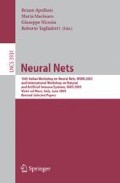Abstract
The universal approximation property is an important characteristic of models employed in the solution of machine learning problems. The possibility of approximating within a desired precision any Borel measurable function guarantees the generality of the considered approach.
The properties of the class of positive Boolean functions, realizable by digital circuits containing only and and or ports, is examined by considering a proper coding for ordered and nominal variables, which is able to preserve ordering and distance. In particular, it is shown that positive Boolean functions are universal approximators and can therefore be used in the solution of classification and regression problems.
Access this chapter
Tax calculation will be finalised at checkout
Purchases are for personal use only
Preview
Unable to display preview. Download preview PDF.
References
Hornik, K., Stinchcombe, M., White, H.: Multilayer feedforward networks are universal approximators. Neural Networks 2, 359–366 (1989)
Park, J., Sandberg, I.W.: Universal approximation using radial-basis-function networks. Neural Computation 3, 246–257 (1991)
Hammer, B., Gersmann, K.: A note on the universal approximation capability of support vector machines. Neural Processing Letters 17, 43–53 (2003)
Boros, E., Hammer, P.L., Ibaraki, T., Kogan, A., Mayoraz, E., Muchnik, I.: An implementation of Logical Analysis of Data. IEEE Transactions on Knowledge and Data Engineering 12, 292–306 (2000)
Muselli, M., Liberati, D.: Binary rule generation via Hamming Clustering. IEEE Transactions on Knowledge and Data Engineering 14, 1258–1268 (2002)
Muselli, M.: Switching Neural Networks: A New Connectionist Model for Classification. In: Apolloni, B., et al. (eds.) WIRN 2005 and NAIS 2005. LNCS, vol. 3931, pp. 23–30. Springer, Berlin (2005)
Muselli, M., Quarati, A.: Reconstructing positive Boolean functions with Shadow Clustering. In: Proceedings of the 17th European Conference on Circuit Theory and Design (ECCTD 2005), Cork, Ireland (August 2005)
Author information
Authors and Affiliations
Editor information
Editors and Affiliations
Rights and permissions
Copyright information
© 2006 Springer-Verlag Berlin Heidelberg
About this paper
Cite this paper
Muselli, M. (2006). Approximation Properties of Positive Boolean Functions. In: Apolloni, B., Marinaro, M., Nicosia, G., Tagliaferri, R. (eds) Neural Nets. WIRN NAIS 2005 2005. Lecture Notes in Computer Science, vol 3931. Springer, Berlin, Heidelberg. https://doi.org/10.1007/11731177_3
Download citation
DOI: https://doi.org/10.1007/11731177_3
Publisher Name: Springer, Berlin, Heidelberg
Print ISBN: 978-3-540-33183-4
Online ISBN: 978-3-540-33184-1
eBook Packages: Computer ScienceComputer Science (R0)

